




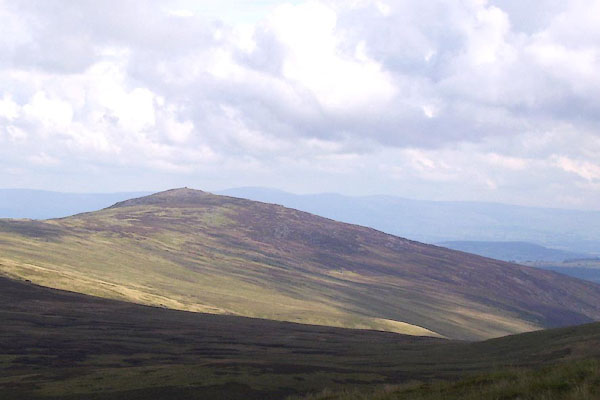
BNZ06.jpg Pike.
(taken 15.8.2007)
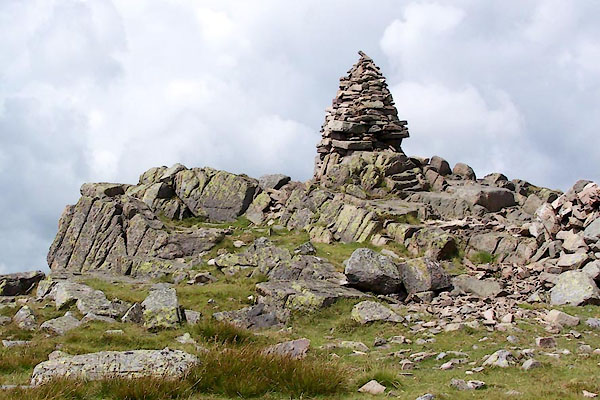
BRC86.jpg Cairn at the top.
(taken 20.7.2009)
placename:- Carrock Fell
placename:- Carrick Heights
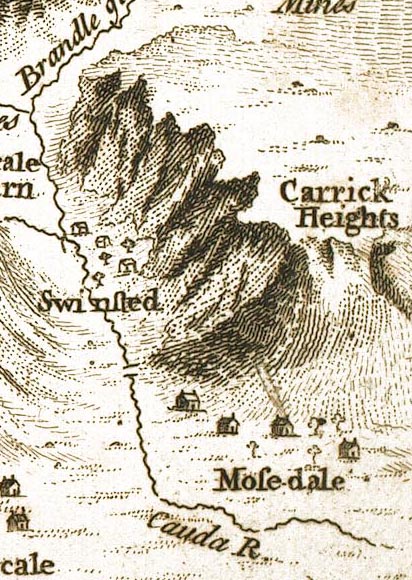
GM1406.jpg
"Carrick Heights"
knobbly hillocks; mountains
item:- Carlisle Library : Map 43
Image © Carlisle Library
placename:- Carrock Fell

D4NY33SW.jpg
"Carrock Fell"
hill hachuring; a hill or mountain
item:- Carlisle Library : Map 2
Image © Carlisle Library
 goto source
goto sourcePage 190:- "A TABLE OF THE Height of Mountains and Lakes SEEN IN THIS TOUR, ... TAKEN FROM THE LEVEL OF THE SEA. ... by Mr. John Dalton."
"Carrock, west-pike, Colbeck ... 744 [yards]"
placename:- Carrick
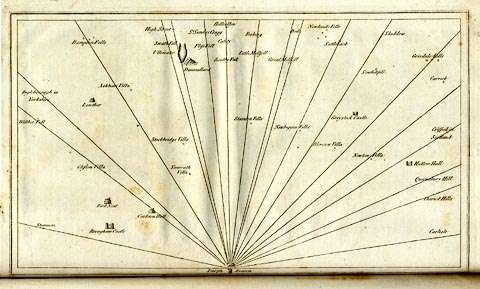 click to enlarge
click to enlargeCL18.jpg
"Carrick"
item:- Armitt Library : A6615.12
Image © see bottom of page
placename:- Carrock
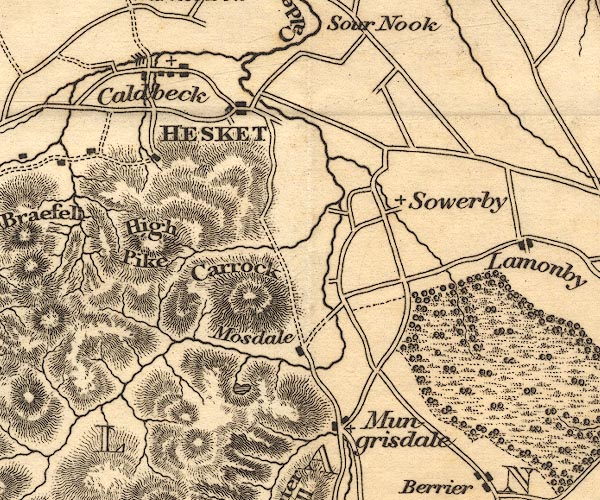
OT02NY33.jpg
item:- JandMN : 48.1
Image © see bottom of page
item:- altitude, Carrock Fell; geology; mineral; glacial erratic; lead; copper; silver
 goto source
goto sourcePage 69:- "CARROCK FELL"
"Makes one of the flanks of that mountain group, whereof Skiddaw forms the crown. It is upwards of 2000 feet in height; and shews a double pointed summit, on which a space appears to have been once inclosed by a wall. Its basis is a crystalline rock composed of a curious variety of materials; and in its neighbourhood are veins of lead and copper, with other mineral substances highly interesting to the mineralogist and geologist."
"..."
 goto source
goto sourcePage 151:- "Carrock Fell consists of a rock generally referred to the class of sienite, varying its appearance in different parts of the mountain. It contains (besides the usual ingredients of quartz and felspar) hypersthene and magnetic or titaniferous iron ore in various proportions. Near this a considerable quantity of lead ore and some copper has been procured: the lead is smelted and refined hard by, and yields a good portion of silver."
"..."
 goto source
goto sourcePage 164:- "... The granite of Caldew and sienite of Carrock can be recognized in Bowlders in the neighbourhood of Carlisle; but are not seen to the south of Keswick. ..."
placename:- Carrick Fell
placename:- Carrick
item:- geology; altitude, Carrock Fell
 goto source
goto sourcePage 95:- "... a portion of country wild and desolate in the extreme, yet interesting to the geologist. On the left is Carrick Fell, its front strewed with immense masses of rock and rivers of debris which encroach on the way below: ..."
 goto source
goto sourcePage 178:- "ELEVATION OF THE MOUNTAINS,"
"ACCORDING TO DIFFERENT AUTHORITIES."
| No. | Names of Mountains. | Dalton. | Otley. | Trig. S. | Jamieson |
| 19 | Carrick, near Caldbeck | 2232 | 2110 | 2290 | 2000 |
placename:- Carrock Fell
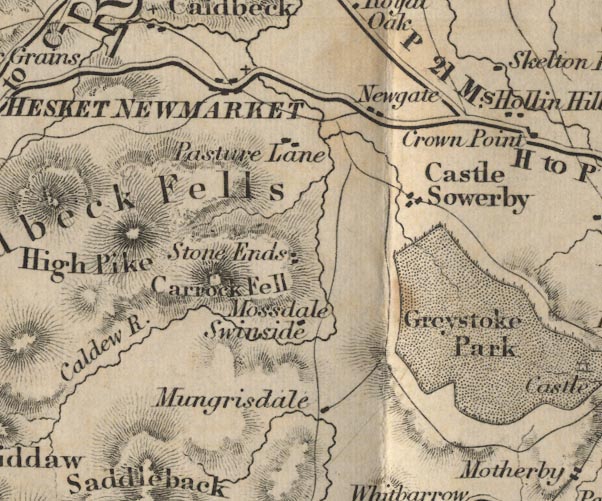
FD02NY33.jpg
"Carrock Fell"
Hill hachuring.
item:- JandMN : 100.1
Image © see bottom of page
placename:- Carrock

GAR2NY33.jpg
"Carrock"
hill hachuring
item:- JandMN : 82.1
Image © see bottom of page
item:- altitude, Carrock Fell
 goto source
goto sourcePage 179:- "A TABLE OF THE HEIGHTS OF MOUNTAINS IN THE COUNTIES OF CUMBERLAND, WESTMORLAND, AND LANCASHIRE."
"No. : Names of Mountains. : Counties. : Height in Feet above the Sea Level."
"18 : Carrock Fell, Caldbeck : Cumberland : 2110"
placename:- Carrock
 goto source
goto sourcePage 11:- "[at the Hesket-Newmarket Inn] ... Mr. Idle and Mr. Goodchild never asked themselves how it came to pass that the men in the fields were never heard of more, how the stalwart landlord replaced them without explanation, how his dog-cart came to be waiting at the door, and how everything was arranged without the least arrangement for climbing to old Carrock's shoulders, and standing on his head."
"Without a word of inquiry, therefore, the Two Idle Apprentices drifted out resignedly into a fine, soft, close, drowsy, penetrating rain; got into the landlord's light dog-cart, and rattled off through the village for the foot of Carrock. The journey at the outset was not remarkable. The Cumberland road went up and down like all other roads; the Cumberland curs burst out from the backs of cottages and barked like other curs, and the Cumberland peasantry stared after the dog-cart amazedly, as long as it was in sight, like the rest of their race. The approach to the foot of the mountain resembled the approaches to the feet of most other mountains all over the world. The cultivation gradually ceased, the trees grew gradually rare, the road became gradually rougher, and the sides of the mountain looked gradually more and more lofty, and more and more difficult to get up. The dog-cart was left at a lonely farm-house. The landlord borrowed a large umbrella, and, assuming in an instant the character of the most cheerful and adventurous of guides, led the way to the ascent. Mr, Goodchild looked eagerly at the top of the mountain, and, feeling apparently that he was now going to be very lazy indeed, shone all over wonderfully to the eye, under the influence of the contentment within and the moisture without. Only in the bosom of Mr. Thomas Idle did Despondency now hold her gloomy state. He kept it a secret; but he would have given a very handsome sum, when the ascent began, to have been back again at the inn. The sides of Carrock looked fearfully steep, and the top of Carrock was hidden in mist. The rain was falling faster and faster. The knees of Mr. Idle - always weak on walking excursions - shivered and shook with fear and damp. The wet was already penetrating through the young man's outer coat to a brand new shooting-jacket, for which he"
 goto source
goto sourcePage 12:- "had reluctantly paid the large sum of two guineas on leaving town; he had no stimulating refreshment about him but a small packet of clammy gingerbread nuts; he had nobody to give him an arm, nobody to push him gently behind, nobody to pull him up tenderly in front, nobody to speak to who really felt the difficulties of the ascent, the dampness of the rain, the denseness of the mist, and the unutterable folly of climbing, undriven, up any steep place in the world, when there is level ground within reach to walk on instead. Was it for this that Thomas had left London? London, where there are nice short walks in level public gardens, with benches of repose set up at convenient distances for weary travellers - London, where rugged stone is humanely pounded into little lumps for the road, and intelligently shaped into smooth slabs for the pavement! No! it was not for the laborious ascent of the crags of Carrock that Idle had left his native city, and travelled to Cumberland. Never did he feel more disastrously convinced that he had committed a very grave error in judgment than when he found himself standing in the rain at the bottom of a steep mountain, and knew that the responsibility rested on his weak shoulders of actually getting to the top of it."
"The honest landlord went first, the beaming Goodchild followed, the mournful Idle brought up the rear. From time to time, the two foremost members of the expedition changed places in the order of march; but the rearguard never altered his position. Up the mountain or down the mountain, in the water or out of it, over the rocks, through the bogs, skirting the heather, Mr. Thomas Idle was always the last, and was always the man who had to be looked after and waited for. At first the ascent was delusively easy, the sides of the mountain sloped gradually, and the material of which they were composed was a soft spongy turf, very tender and pleasant to walk upon. After a hundred yards or so, however, the verdant scene and the easy slope disappeared, and the rocks began. Not noble, massive rocks, standing upright, keeping a certain regularity in their positions, and possessing, now and then, flat tops to sit upon, but little irritating, comfortless, rocks, littered about anyhow by Nature; treacherous, disheartening rocks of all sorts of small shapes, and small sizes, bruisers of tender toes and trippers-up of wavering feet. When these impediments were passed, heather"
 goto source
goto sourcePage 13:- "and slough followed. Here the steepness of the ascent was slightly mitigated; and here the exploring party of three turned round to look at the view below them. The scene of the moorland and fields was like a feeble water-colour drawing half sponged out. The mist was darkening, the rain was thickening, the trees were dotted about like spots of faint shadow, the division-lines which mapped out the fields were all getting blurred together, and the lonely farm-house where the dog-cart had been left, loomed spectral in the grey light like the last human dwelling at the end of the habitable world. Was this a sight worth climbing to see? Surely - surely not!"
"Up again - for the top of Carrock is not reached yet. The landlord, just as good-tempered and obliging as he was at the bottom of the mountain. Mr. Goodchild brighter in the eyes and rosier in the face than ever; full of cheerful remarks and apt quotations; and walking with a springiness of step wonderful to behold. Mr Idle, farther and farther in the rear, with the water squeaking in the toes of his boots, with his two-guinea shooting-jacket clinging damply to his aching sides, with his overcoat so full of rain, and standing out so pyramidically stiff, in consequence, from his shoulders downwards, that he felt as if he was walking in a giant extinguisher - the despairing spirit within him representing but too aptly the candle that had just been put out. Up and up and up again, till a ridge is reached and the outer edge of the mist on the summit of Carrock is darkly and grizzingly near. Is this the top? No, nothing like the top. It is an aggravating peculiarity of all mountains, that, although they have only one top when they are seen (as they ought always to be seen) from below, they turn out to have a perfect eruption of false tops whenever the traveller is sufficiently ill-advised to go out of his way for the purpose of ascending them. Carrock is but a trumpery little mountain of fifteen hundred feet, and it presumes to have false tops, and even precipices, as if it were Mont Blanc. No matter; Goodchild enjoys it, and will go on; and Idle, who is afraid of being left behind by himself, must follow. On entering the edge of the mist, the landlord stops, and says he hopes it will not get any thicker. It is twenty years since he last ascended Carrock, and it is barely possible, if the mist increases, that the party may be lost on the mountain. Goodchild hears this dreadful"
 goto source
goto sourcePage 14:- "intimation, and is not in the least impressed by it. He marches for the top that is never to be found, as if he was the Wandering Jew, bound to go on for ever, in defiance of everything. The landlord faithfully accompanies him. The two, to the dim eye of Idle, far below, look in the exaggerative mist, like a pair of friendly giants, mounting up the steps of some invisible castle together. Up and up, and then down a little, and then up, and then along a strip of level ground, and then up again. The wind, a wind unknown in the happy valley, blows keen and strong; the rain-mist gets impenetrable; a dreary little cairn of stones appears. The landlord adds one to the heap, first walking all round the cairn as if he were about to perform an incantation, then dropping the stone on to the top of the heap with the gesture of a magician adding an ingredient to a cauldron in full bubble. Goodchild sits down by the cairn as if it was his study table at home; Idle, drenched and panting, stands up with his back to the wind, ascertains distinctly that this is the top at last, looks round with all the little curiosity that is left in him, and gets, in return, a magnificent view of - Nothing!"
"The affect of this sublime spectacle on the minds of the exploring party is a little injured by the nature of the direct conclusion to which the sight of it points - the said conclusion being that the mountain mist has actually gathered round them, as the landlord feared it would. It now becomes imperatively necessary to settle the exact situation of the farm-house in the valley at which the dog-cart has been left, before the travellers attempt to descend. While the landlord is endeavouring to make this discovery in his own way, Mr. Goodchild plunges his hand under his wet coat, draws out a little red morocco-case, opens it, and displays to the view of his companions a neat pocket-compass. The north is found, the pint at which the farm-house is situated is settled, and the descent begins. After a little downward walking, Idle (behind as usual) sees his fellow-travellers turn sharply aside - tries to follow them - loses them in the mist - is shouted after, waited for, recovered - and then finds that a halt has been ordered, partly on his account, partly for the purpose of again consulting the compass."
"The point in debate is settled as before between Goodchild and the landlord, and the expedition moves on, not down the mountain, but marching straight forward round the slope of it."
 goto source
goto sourcePage 15:- "The difficulty of following this new route is acutely felt by Thomas Idle. He finds the hardship of walking at all greatly increased by the fatigue of moving his feet straight forward along the side of a slope, when their natural tendency, at every step, is to turn off at a right angle, and go straight down the declivity. Let the reader imagine himself to be walking along the roof of a barn, instead of up or down it, and he will have an exact idea of the pedestrian difficulty in which the travellers had now involved themselves. In ten minutes more Idle was lost in the distance again, was shouted for, waited for, recovered as before; found Goodchild repeating his observation of the compass, and remonstrated warmly against the sideways route that his companions persisted in following. It appeared to the uninstructed mind of Thomas that when three men want to get to the bottom of a mountain, their business is to walk down it; and he put this view of the case, not only with emphasis, but even with some irritability. He was answered from the scientific eminence of the compass on which his companions were mounted, that there was a frightful chasm somewhere near the foot of Carrock, called the Black Arches, into which the travellers were sure to march in the mist, if they risked continuing the descent from the place where they had now halted. Idle received this answer with the silent respect which was due to the commanders of the expedition, and followed along the roof of the barn, or rather the side of the mountain, reflecting upon the assurance which he received on starting again, that the object of the party was only to gain "a certain point," and, this haven attained, to continue the descent afterwards until the foot of Carrock was reached. Though quite unexceptionable as an abstract form of expression, the phrase "a certain point" has the disadvantage of sounding rather vaguely when it is pronounced on unknown ground, under a canopy of mist much thicker than a London fog. Nevertheless, after the compass, this phrase was all the clue the party had to hold by, and Idle clung to the extreme end of it as hopefully as he could."
"More sideways waking, thicker and thicker mist, all sorts of points reached except the "certain point;" third loss of Idle, third shouts for him, third recovery of him, third consultation of compass. Mr. Goodchild draws it tenderly from his pocket, and prepares to adjust it on a stone. Something falls on the"
 goto source
goto sourcePage 16:- "turf - it is the glass. Something else drops immediately after - it is the needle. The compass is broken, and the exploring party is lost!"
"It is the practice of the English portion of the human race to receive all great disasters in dead silence. Mr. Goodchild restored the useless compass to his pocket without saying a word, Mr. Idle looked at the landlord, and the landlord looked at Mr. Idle. There was nothing for it now but to go on blindfold, and trust to the chapter of chances. Accordingly, the lost travellers moved forward, still walking round the slope of the mountain, still desperately resolved to avoid the Black Arches, and to succeed in reaching the "certain point.""
"A quarter of an hour brought them to the brink of a ravine, at the bottom of which there flowed a muddy little stream. Here another halt was called, and another consultation took place. The landlord, still clinging pertinaciously to the idea of reaching the "point," voted for crossing the ravine, and going on round the slope of the mountain. Mr. Goodchild, to the great relief of his fellow-traveller, took another view of the case, and backed Mr. Idle's proposal to descend Carrock at once, at any hazard - the rather as the running stream was a sure guide to follow from the mountain to the valley. Accordingly, the party descended to the rugged and stony banks of the stream; and here again Thomas lost ground sadly, and fell far behind his travelling companions. Not much more than six weeks had elapsed since he had sprained one of his ankles, and he began to feel the same ankle getting rather weak when he found himself among the stones that were strewn about the running water. Goodchild and the landlord were getting farther and farther ahead of him. He saw them cross the stream and disappear round a projection on its banks. He heard them shout the moment after as a signal that they had halted and were waiting for him. Answering the shout, he mended his pace, crossed the stream where they had crossed it, and was within one step of the opposite bank, when his foot slipped on a wet stone, his weak ankle gave a twist outwards, a hot, rending, tearing pain ran through it at the same moment, and down fell the idlest of the Two Idle Apprentices, crippled in an instant."
"The situation was now, in plain terms, one of absolute"
 goto source
goto sourcePage 17:- "danger. There lay Mr. Idle writhing with pain, there was the mist as thick as ever, there was the landlord as completely lost as the strangers whom he was conducting, and there was the compass broken in Goodchild's pocket. To leave the wretched Thomas on an unknown ground was plainly impossible; and to get him to walk with a badly sprained ankle seemed equally out of the question. However, Goodchild (brought back by his cry for help) bandaged the ankle with a pocket-handkerchief, and assisted by the landlord, raised the crippled Apprentice to his legs, offered him a shoulder to lean on, and exhorted him for the sake of the whole party to try if he could walk. Thomas, assisted by the shoulder on one side, and a stick on the other, did try, with what pain and difficulty those only can imagine who have sprained an ankle and have had to tread on it afterwards. At a pace adapted to the feeble hobbling of a newly-lamed man, the lost party moved on, perfectly ignorant whether they were on the right side of the mountain or the wrong, and equally uncertain how long Idle would be able to contend with the pain in his ankle, before he gave in altogether and fell down again, unable to stir another step."
"Slowly and more slowly, as the clog of crippled Thomas weighed heavily and more heavily on the march of the expedition, the lost travellers followed the windings of the stream, till they came to a faintly-marked cart-track, branching off nearly at right angles, to the left. After a little consultation it was resolved to follow this dim vestige of a road in the hope that it might lead to some farm or cottage, at which Idle could be left in safety, It was now getting on towards the afternoon, and it was fast becoming more doubtful whether the party, delayed in their progress as they now were, might not be overtaken by the darkness before the right route was found, and be condemned to pass the night on the mountain, without bit or drop to comfort them, in their wet clothes."
"The cart-track grew fainter and fainter, until it was washed out altogether by another little stream, dark, turbulent, and rapid. The landlord suggested, judging by the colour of the water, that it must be flowing from one of the lead mines in the neighbourhood of Carrock; and the travellers accordingly kept by the stream for a little while, in the hope of possibly wandering towards help in that way. After walking forward about"
 goto source
goto sourcePage 18:- "two hundred yards, they came upon a mine indeed, but a mine, exhausted and abandoned; a dismal ruinous place, with nothing but the wreck of its works and buildings left to speak for it. Here, there were a few sheep feeding. The landlord looked at them earnestly, thought he recognized the marks on them - then thought he did not - finally gave up the sheep in despair - and walked on just as ignorant of the whereabouts of the party as ever."
"The march in the dark, literally as well as metaphorically in the dark, had now been continued for three-quarters of an hour from the time when the crippled Apprentice had met with his accident. Mr. Idle, with all the will to conquer the pain in his ankle, and to hobble on, found the power rapidly failing him, and felt that another ten minutes at most would find him at the end of his last physical resources. He had just made up his mind on this point, and was about to communicate the dismal result of his reflections to his companions, when the mist suddenly brightened, and begun to lift straight ahead. In another minute, the landlord, who was in advance, proclaimed that he saw a tree. Before long, other trees appeared - then a cottage - then a house beyond the cottage, and a familiar line of road rising behind it. Last of all, Carrock itself loomed darkly into view, far away to the right hand. The party had not only got down the mountain without knowing how, but had wandered away from it in the mist, without knowing why - away, far down on the very moor by which they had approached the base of Carrock that morning."
"The happy lifting of the mist, and the still happier discovery that the travellers had groped their way, though by a very roundabout direction, to within a mile or so of the part of the valley in which the farm-house was situated, restored Mr. Idle's sinking spirits and reanimated his failing strength. While the landlord ran to get the dog-cart, Thomas was assisted by Goodchild to the cottage which had been the first building seen when the darkness brightened, and was propped up against the garden wall, like an artist's lay figure waiting to be forwarded, until the dog-cart should arrive from the farm-house below. In due time - and a very long time it seemed to Mr. Idle - the rattle of wheels was heard, and the crippled Apprentice was lifted into the seat. As the dog-cart was driven back to the inn,"
 goto source
goto sourcePage 19:- "the landlord related an anecdote which he had just heard at the farm-house, of an unhappy man who had been lost, like his two guests and himself, on Carrock; who had passed the night there alone; who had been found the next morning, "scared and starved;" and who never went out afterwards, except on his way to the grave. Mr. Idle heard this sad story, and derived at least one useful impression from it. Bad as the pain in his ankle was, he contrived to bear it patiently, for he felt grateful that a worse accident had not befallen him in the wilds of Carrock."
placename:- Carrock
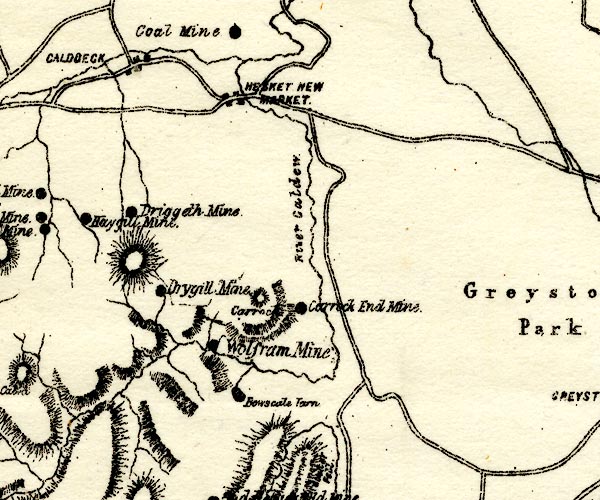
PST2NY33.jpg
"Carrock"
hill hachuring
item:- JandMN : 162.2
Image © see bottom of page
placename:- Carrock Fell
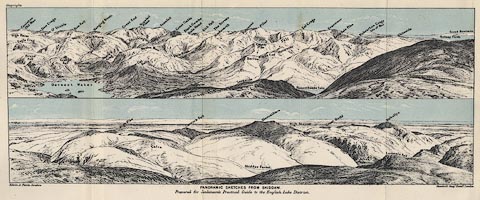 click to enlarge
click to enlargeJk01E2.jpg
"... Carrock Fell ..."
item:- JandMN : 28.8
Image © see bottom of page
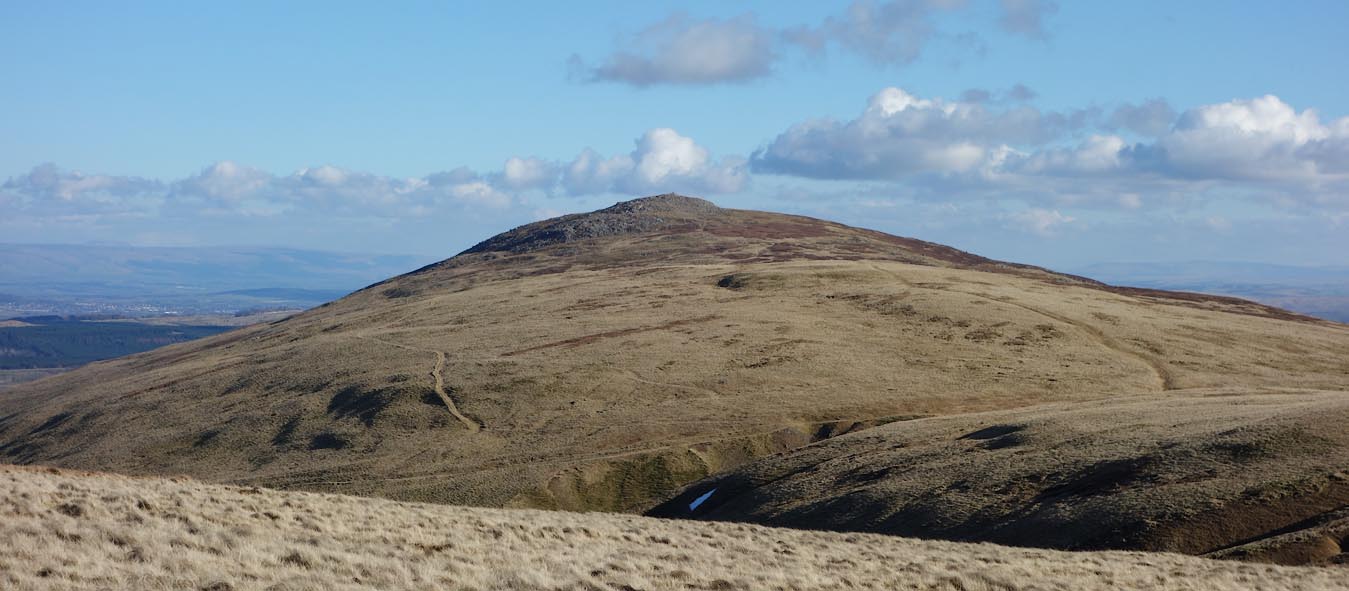
Click to enlarge
CAA80.jpg (taken 3.3.2014)

Click to enlarge
BVC94.jpg (taken 3.8.2011)
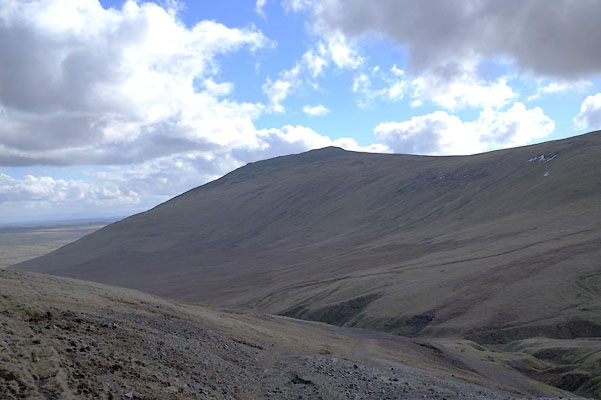
BZZ67.jpg (taken 3.3.2014)
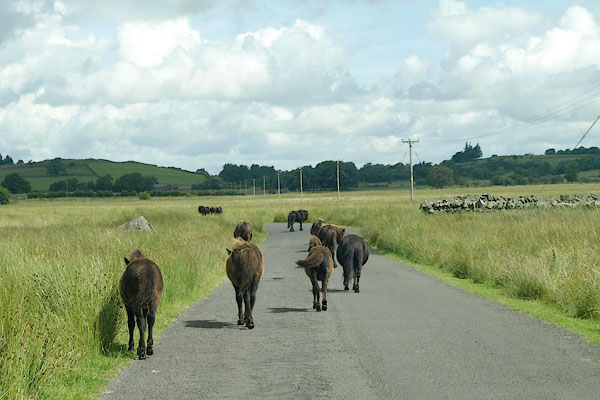
BRC21.jpg Wild ponies.
(taken 20.7.2009)
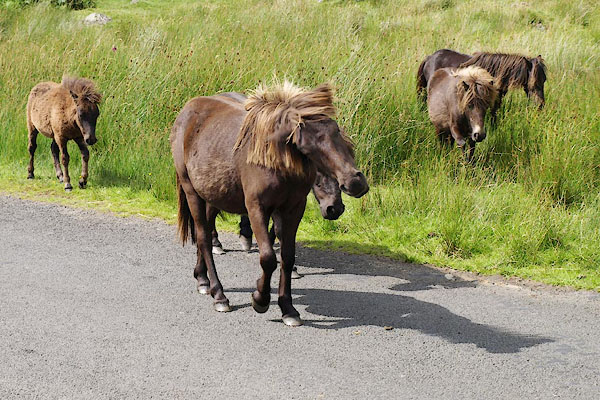
BRC20.jpg Wild ponies.
(taken 20.7.2009)
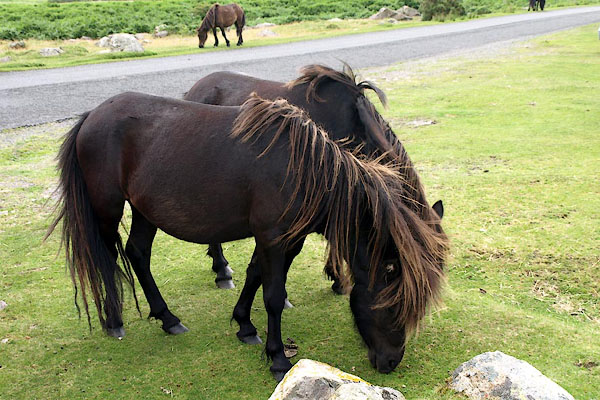
BRC22.jpg Wild ponies.
(taken 20.7.2009)
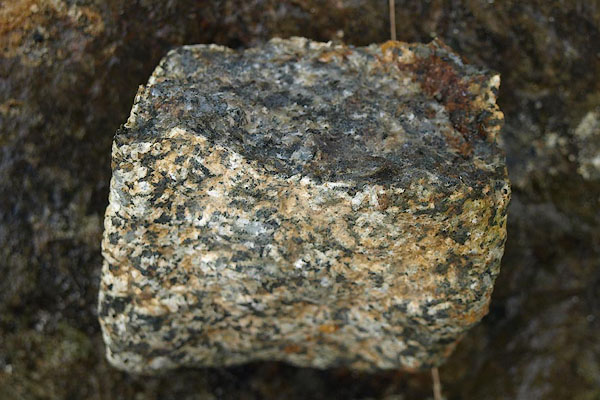
BPQ25.jpg Gabbro from Carrock Fell, intrusive igneous/plutonic rock; found lower down by the River Caldew. Coarse crystals from slower cooling; white - plagioclase, black - pyroxene, some greenish chlorite, the outer surface weathers to an 'albite'.
(taken 24.8.2008)
